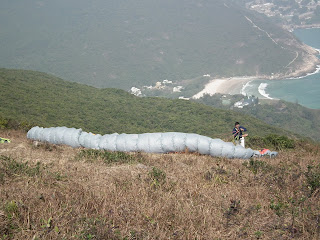What does the word "hike" mean? A dictionary I consulted said it meant: "to walk a long distance especially for pleasure or exercise." Being an American, it implies to me that it is a long walk in a natural setting with few people, as opposed to walking in a city. And we would understand that you better take water and lunch with you. I don't think an American would say that we take a "hike" through Central Park in NYC. We would instead say that we are going to take a long "walk" through Central Park. In New Zealand, some saying they are going tramping is synonymous with an American saying they are going hiking. It implies walking a long distance for pleasure or exercise in a natural setting with fewer people, where you take your lunch with you to have along the way.
Karis and I went on a church "hike" yesterday. The announcement in the bulletin said it was a "half-day adventure through Phoenix Mountain Forest Park in Shenzhen." Mmmm. Shenzhen is across the border in China and is basically the industrial source region for all our products in the U.S. that say "made in China." I'll write more about Shenzhen at another time...
We were intrigued. It sounded like an adventure. We had one more entry on our visas for China. We wanted to get to know some people from the church we are attending.
As is typical for outings in Hong Kong, the instructions said to meet at a particular exist off the subway line. Karis and I left at 9 a.m. from our apartment in order to be at the appointed place at 10 a.m. We met everyone and got introduced at Exit B of the Tuen Mun Station on the West Rail Line, and set off.
From the Tuen Mun Station we caught a double decker bus that took us up and over the mountain and across a long bridge that passes over the Shenzhen Bay. There we departed and went through Hong Kong immigration to leave and through Chinese immigration to enter (yes--one country but two systems). From that border we caught an express bus to the Shenzhen airport. From the Shenzhen airport we caught a local bus that went through industrial areas and whose last stop was the Phoenix Mountain Forest Park--12:30 p.m.

From home to border


From border to park.


The entrance to the mountain park--cement fence in front of rock. Is the rock natural?
As is typical, a huge open plaza, lined with shops on both sides framed the entrance to the park. We started up the mountain. The way up was a stairway--one way. The line of people made their way up. After doing the first part of the mountain stairway, we found ourselves on another flat open plaza where there were buildings and a temple. Incense, people, and firecrackers were abundant. We didn't need our lunch because we went and ate at one of the restaurants :) I think I am seeing a relationship amongst high places, Buddhist temples, and tourism.

The "path"

Karis decided to eat her peanut butter and jelly sandwich but in a culturally appropriate way.

The lion dance
After a good lunch, we joined the line of people going up the rest of the stairway, ending up at a tower that was around 440 meters high. At several points along the way, we saw small establishments that sold snacks and drinks. One of the amazing things along the route were women making there way up in high heels and nice dresses. This made me ponder the question of differences in culturally appropriate clothes for "hikes."
But probably the most interesting thing of the trip was the discovery that many of the wooden handrails and logs for sitting were in fact cement made to look like wood--pseudo nature. And of course, the haze from the industrial pollution was incredible. At one point I asked Karis to feel the bark of a tree for me to see if it was real. I started questioning my own senses.


Pseudo-natural forms. Cement is made from natural products after all.




Back on the street for supper. We had shrink-wrapped dishes to ensure they were clean. I suspect they are washed in the back and then shrink-wrapped with some machine.
We came down the mountain by the "down" path, along with hundreds of others. We reached the bottom plaza to find someone in high heels and a fur coat playing bad mitten. We walked down the street--in China, streets tend to be in a grid pattern and broad unlike crowded Hong Kong--to find a restaurant for supper. Hikes in Hong Kong (and China?) always end with a big Chinese supper at a restaurant.
Sometime before 7 p.m. we headed home. By then it was dark. Karis asked me: "Do you see haze or is that just my imagination?" As you looked out across the street in Shenzhen the haze from the pollution was visible. We took the local bus back to the Shenzhen airport. We took the express bus from the airport back to the border. We went through the Chinese border and then through Hong Kong immigration. From there we all split up, having been able to find buses that went directly back to our individual parts of the city. When we got off the bus I asked Karis: "Does the air seem clearer to you here in Hong Kong?" She looked around seeing the lights in the buildings on the mountain behind our neighborhood and confirmed my sense of reality. We arrived back at home around 10:30 p.m. A hike or a long walk? I can't say. But it was an adventure--good exercise, good fellowship, and interesting time!

















































